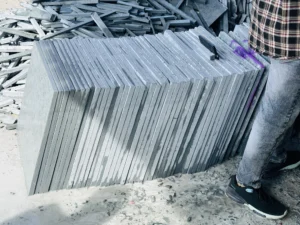kota stone polishing process
Kota stone, a type of fine-grained limestone, is quarried in the Kota district of Rajasthan, India. It is known for its durability, natural beauty, and versatility, making it a popular choice for flooring in residential and commercial spaces. The process of polishing Kota stone is crucial to enhance its aesthetic appeal and longevity. This article delves into the detailed steps involved in the Kota stone polishing process, highlighting the importance of each phase to achieve a smooth, lustrous finish.
1. Preparing the Stone
Before polishing can begin, the Kota stone slabs must be prepared. This involves cutting the stones to the desired size and shape using a diamond-tipped saw. The edges are then smoothed and shaped to ensure uniformity in thickness and dimensions. Any surface irregularities are corrected in this phase to guarantee a flat surface that will polish evenly.
2. Initial Grinding
The first step in the polishing process is grinding the stone surface with a coarse abrasive pad. This is typically done with a heavy-duty grinder that can handle the hardness of Kota stone. The initial grinding removes any roughness or unevenness on the surface, erasing scratches, stains, or other blemishes. This step is crucial for creating a uniform surface that will polish well.
3. Honing
After the rough grind, the stone undergoes honing. Honing involves the use of finer grits of diamond abrasives, which smooth the stone surface further and start to bring out its natural luster. This phase requires patience and precision to ensure an even, semi-polished finish. Water is often used during honing to minimize dust and aid in achieving a smoother surface.
4. Polishing
The polishing phase is where the true transformation occurs. Specialized polishing pads or powders that may contain tin oxide or other polishing agents are used to achieve a high gloss finish. The stone is polished in several passes, with each pass using finer and finer abrasives. The process continues until the desired level of shine is achieved. During this phase, it’s essential to keep the stone wet to reduce dust and enhance the polish.
5. Sealing
Once the stone is polished to a high sheen, it is then sealed to protect its surface. Sealing Kota stone helps in resisting stains, spills, and moisture absorption. A quality stone sealer is applied evenly over the surface and allowed to penetrate the stone for enhanced protection. This step not only preserves the stone’s beauty but also extends its lifespan by making it more resistant to wear and tear.
6. Maintenance
After polishing and sealing, regular maintenance is essential to keep the stone’s appearance. This includes routine cleaning with a pH-neutral cleaner and periodic resealing, depending on the traffic and usage of the area.
Conclusion
The Kota stone polishing process is a meticulous and labor-intensive procedure that transforms the raw stone into a beautiful and durable flooring option. Each step, from initial grinding to sealing, plays a vital role in achieving the desired finish and durability of the stone. Properly polished and maintained Kota stone flooring can last for decades, making it a wise investment for both residential and commercial properties. The allure of Kota stone lies not just in its natural beauty but also in its ability to withstand the test of time when given the proper care and finish.


